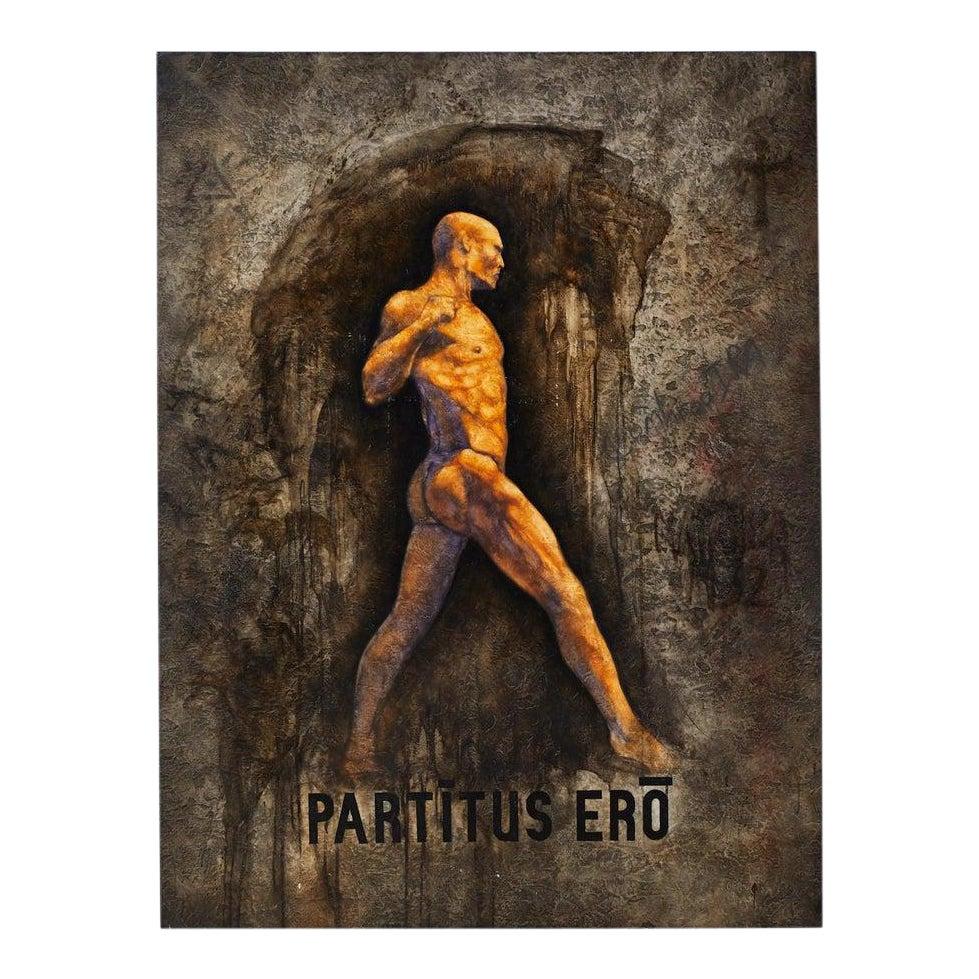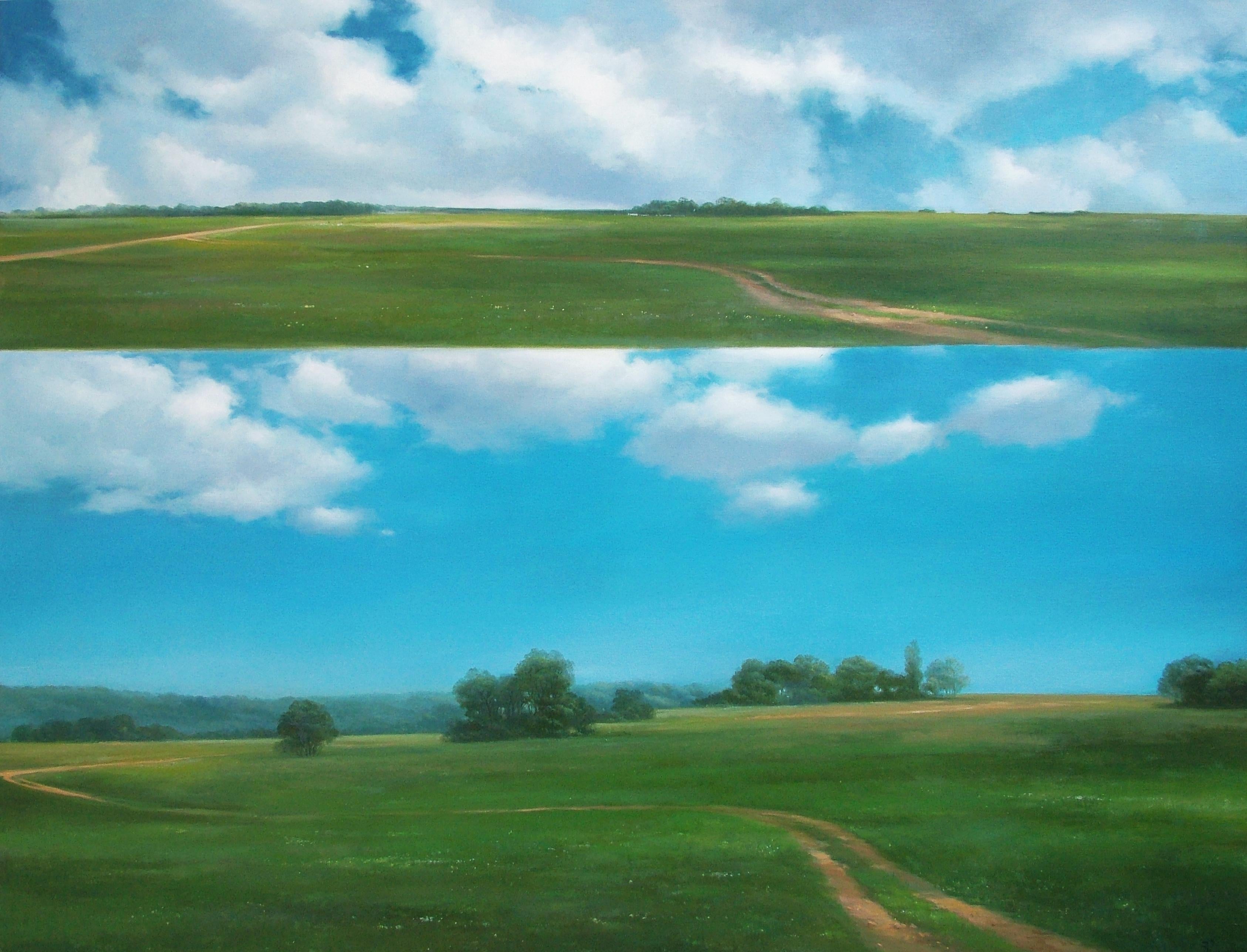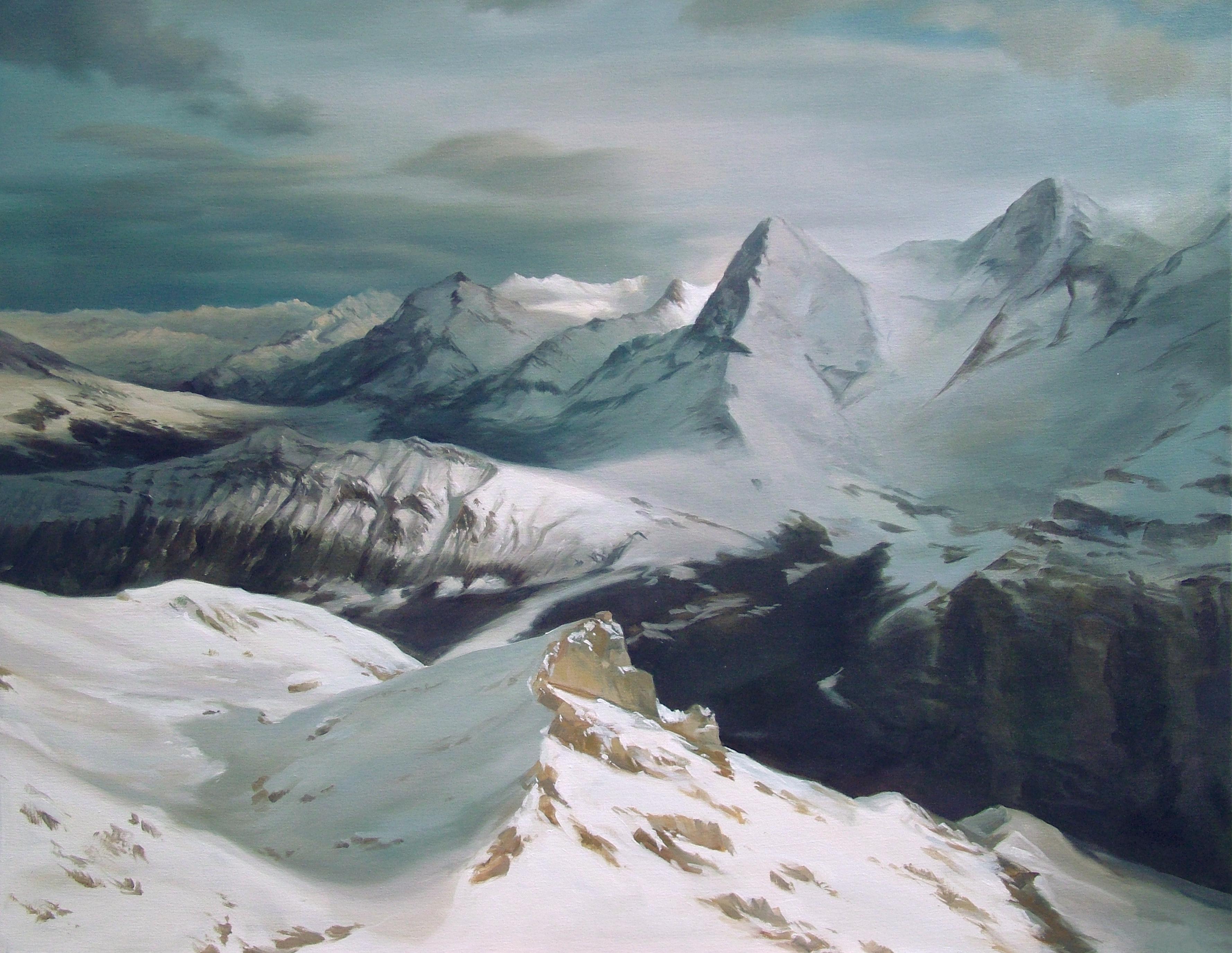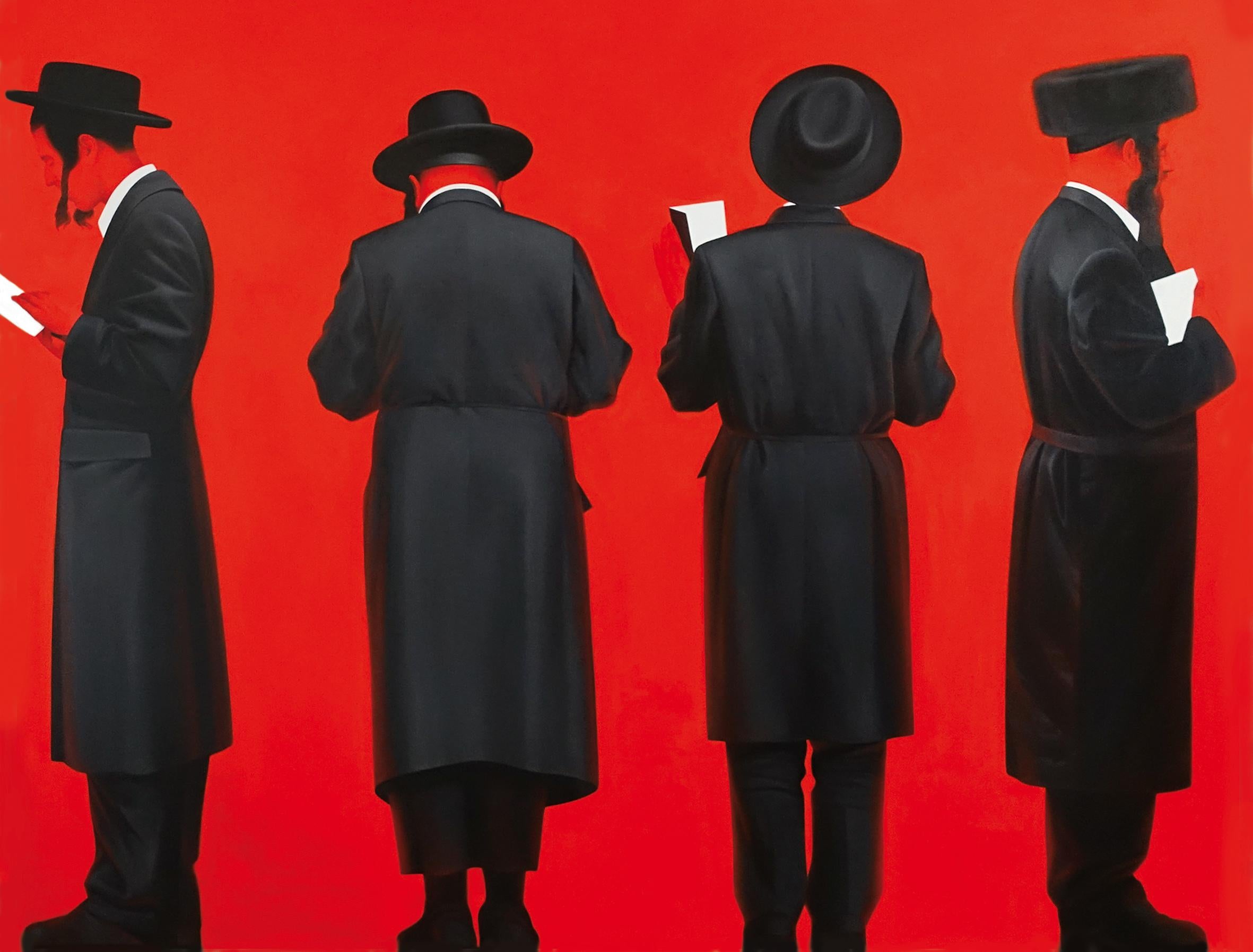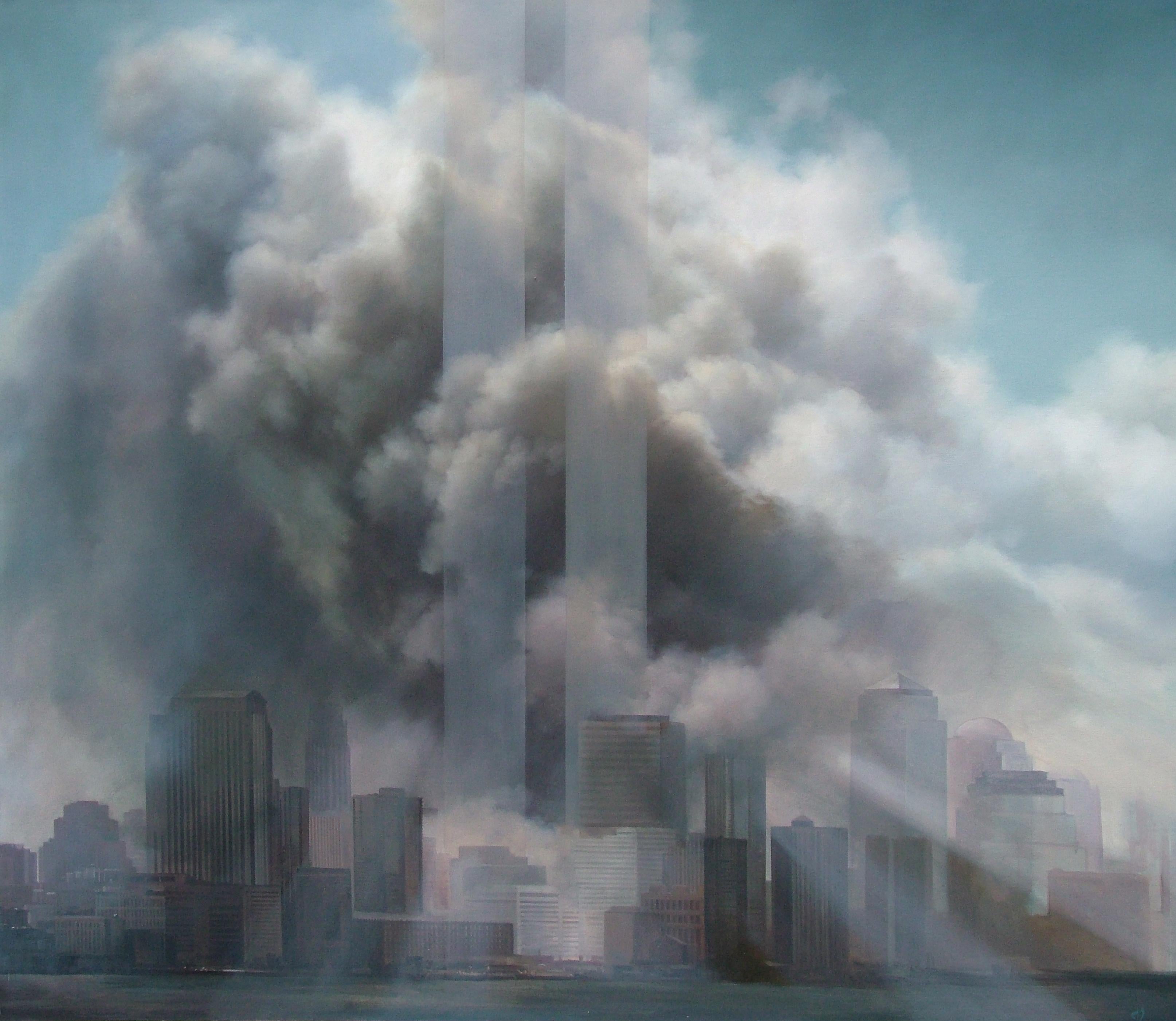Items Similar to Large Surrealist Symbolist Painting, Peeking Child, Moorish Architectural Arches
Want more images or videos?
Request additional images or videos from the seller
1 of 8
Baruch ElronLarge Surrealist Symbolist Painting, Peeking Child, Moorish Architectural Arches
About the Item
Large Surrealist Symbolist Painting With a peeking, peering figure of a child dressed in red in a typical Middle Eastern Architectural setting. (unframed 28.75X39.5 inches)
Baruch Elron (1934–2006) was an Israeli painter best known for his unique Fantastic Realist style rich in symbols and allegories.
Baruch Elron (Barbu Teodorescu) was born in Bucharest, in a family of Sephardic Jews.
Baruch Elron studied Painting at the Nicolae Grigorescu Fine Arts Academy in Bucharest. Among his teachers were the great artists Corneliu Baba, Alexandru Ciucurencu, Jean Alexandru Steriadi and Yosef Molnar.
During his student years, Elron made several study trips to Moscow, Prague and Budapest where he spent his time in the museums, studying the great masters.
In 1958, he was granted the Excellency Award at the International Art Fair of Rio de Janeiro, Brazil. A year later, in Moscow, he received the prize of the Moscow Youth Festival.
After graduating from the academy, he began to work as a graphic artist, as a book illustrator and in advertising.
In 1960, he received the Prize for Book Illustration at the Dresden Book Fair in Germany.
In 1961, he married Lydia Elron and together with both their families immigrated to Israel, two years later. At the departure from Romania, the Romanian Communist officials prevented him from taking his own paintings, so all of his works up to that time were abandoned in Romania.
The beginning in Israel was difficult, with the birth of the couple’s first child and the participation of Elron to the three wars that followed. After working in advertising and in the police reconstitution department, Baruch Elron decided that he could not dedicate his time to anything else apart from painting.
In 1966, Israeli, Baruch Elron had his first solo exhibition in Tel Aviv, closely followed by many others: New York City (1967), Montreal and Toronto (1969).
Between 1974-1976, he took part at the International Art Fair of Düsseldorf and Koln, in Germany. In the following years, he had solo exhibitions in almost all the biggest cities of Germany and in museums such as The Solingen Art Museum and Gustav Lubke Museum.
He also exhibited in France, Austria, Quadrienale di Roma Italy, Belgium, Croatia, Abidjan, Romania, United States and of course in Israel among many other countries.
In 1997, he received the ACMEOR Prize for Plastic Arts and in 1998 Baruch Elron was granted the Israel Jubilee Award, for artistic and cultural achievements.
In 2000, he was offered the Special recognition award by the Iancolovici Foundation, in Haifa.
Between 1985–1994, Baruch Elron was the Chairman of the Union of Artists of Israel. He also taught painting at the Herzliya Art Museum, the Warrior’s House (where he used painting in order to psychologically treat Israel’s wounded soldiers) and at the Popular University.
In 2006, Baruch Elron died in Tel Aviv, leaving behind many unfinished works.
Posthumous recognition
Retrospective exhibitions took place in Israel, Monaco, France, Romania.
In 2011 and 2012, several artworks of Baruch Elron were displayed at the International collective exhibitions “The Spirit of Art” in London and “Lights in Winter” (The Archeological Museum of Jaffa, Israel ) and “Israel’s Gems”, in the U.K.
In 2011, Baruch Elron’s painting “Exodus” appeared on the cover of the book “Maranatha”, Niram Art Publishing House, Madrid.
Elron’s art can be included in Fantastic Realism with some Surrealist influences.
In the catalogue of one of Elron’s exhibition in the Mittlerhein Museum in Koblenz (1982), Germany, Helga Zahler defined Elron’s art as a “painted dream”. The artist once described his works as “Romantic-Optimistic Surrealism”.
In the book “The Magical World of Baruch Elron”, art historian Miriam Or further explains: “The school called Fantastic Realism with which Elron is identified, was created in Vienna after the Second World War, but it is deeper roots spring from ancient history. Elron himself makes this connection between his approach and that of enigmatic expressions of artists such as Hieronymus Bosch, Bruegel and Durer, Henri Fusei and William Blake. On the other hand, Elron links the subjects of his works to expressions based in literature, poetry, drama, sayings, maxims, fables and philosophical ideas taken from different humanistic cultures. His own fantastic approach is based on and echoes medieval art, the 19th-century symbolists, 20th-century Surrealist art, Viennese Fantastic Realism (Ernst Fuchs, Arik Brauer, Rudolf Hausner etc.) , in addition to the Humanist and Virtual art of the late 20th and the beginning of the 21st century.
Themes tackled in his vast art creation are the symbolism of the bird, Judaica, the Bible, the portrait, light and shadow and the myth of creation, the four elements of nature, metamorphosis, etc.
- Creator:Baruch Elron (1934 - 2006, Israeli, Romanian)
- Dimensions:Height: 43.5 in (110.49 cm)Width: 33 in (83.82 cm)
- Medium:
- Movement & Style:
- Period:
- Condition:minor surface wear commensurate with age.
- Gallery Location:Surfside, FL
- Reference Number:1stDibs: LU38211300362
About the Seller
4.9
Platinum Seller
These expertly vetted sellers are 1stDibs' most experienced sellers and are rated highest by our customers.
Established in 1995
1stDibs seller since 2014
1,548 sales on 1stDibs
Typical response time: 1 hour
- ShippingRetrieving quote...Ships From: Surfside, FL
- Return PolicyA return for this item may be initiated within 3 days of delivery.
More From This SellerView All
- French Surrealist Circus Scene, Children with Balloons Oil Painting J.P. SerrierBy Jean Pierre SerrierLocated in Surfside, FL14.5x10.5 framed, 9X5 without frame Jean Pierre Serrier (1934 – 1989) was a French painter known for surrealism and absurdist art. Jean-Pierre Serrier was born in Montparnasse, Paris and attended the Académie des Beaux-Arts in Paris. the son of Louis and Solange Serrier. His father fought in World War II and became a prisoner of war. In 1940, as a six-year-old, he and his mother fled Paris for Corrèze in southwest France. Childhood memories of close escapes from German bombardments would later influence his absurdist philosophy of life. Passionate about drawing, in 1951 he applied and was admitted to the École nationale supérieure des arts appliqués et des métiers d'art in Paris. He shared an attic apartment in the 16th arrondissement with fellow student Jean-Baptiste Valadié. For income, he decorated shop windows. A trip to Spain provided motifs for early works. His student work might be characterized as art naïf...Category
20th Century Surrealist Figurative Paintings
MaterialsCanvas, Oil
- Atlantis, Large Surrealist Oil Painting. Viennese Fantastic RealismBy Peter KolinLocated in Surfside, FLAtlantis, A large spectacular nautical, marine magic fantasy. (without the frame it is 32X39 inches) The roots for Peter Kolin’s fascinating world of Surrealist Fantasy, Magic Realist images can be traced back to the art of Mannerism, a brief period - approximately 1520 to 1610 - between the Renaissance and Age of the Baroque. In Mannerist paintings composition had no focal point and space could be ambiguous. Surreal figures could be characterized by athletic bending and twisting with distortions, exaggerations, elastic elongation of the limbs, bizarre or graceful posturing and the rendering of the heads as uniformly small and oval. (reminds me very much of some of the compositions of Salvador Dali) The composition was full of clashing symbolist colors very unlike the balanced, natural and often dramatic colors of the High Renaissance. Mannerist works presented instability and restlessness and also showed a fondness for allegories with lascivious undertones. Kolin, an exceptionally gifted painter within this tradition, creates gorgeous and mysterious fantasies of Surrealism with each work opening a new and more exciting fantastic world. His narrative world of images and symbols is presented in his own metaphorical language but with a visual accuracy solidly rooted in technical perfection. Today Kolin is a widely acclaimed artist of the Vienna School of Fantastic Realism. (Together with, Arik Erich Brauer, Ernst Fuchs, Rudolf Hausner...Category
1980s Surrealist Figurative Paintings
MaterialsCanvas, Oil
- French Mod Surrealist Commedia dell'arte Circus Scene Oil Painting J.P. SerrierBy Jean Pierre SerrierLocated in Surfside, FLJean Pierre Serrier (French, 1934-1989) Oil on canvas painting depicting four figures Hand signed lower right. Measures (frame) 26.5" x 30" wide, and (sight) 18.25." x 22.25" wide. Jean Pierre Serrier (1934 – 1989) was a French painter known for surrealism and absurdist art. Jean-Pierre Serrier was born in Montparnasse, Paris and attended the Académie des Beaux-Arts in Paris. the son of Louis and Solange Serrier. His father fought in World War II and became a prisoner of war. In 1940, as a six-year-old, he and his mother fled Paris for Corrèze in southwest France. Childhood memories of close escapes from German bombardments would later influence his absurdist philosophy of life. Passionate about drawing, in 1951 he applied and was admitted to the École nationale supérieure des arts appliqués et des métiers d'art in Paris. He shared an attic apartment in the 16th arrondissement with fellow student Jean-Baptiste Valadié. For income, he decorated shop windows. A trip to Spain provided motifs for early works. His student work might be characterized as art naïf (Naive art). While still a student, he sold a ceramic artwork to the poet and publisher Pierre Seghers, who would later commission drawings from him. He frequented jazz clubs in Saint-Germain des Près, and while listening to Sidney Bechet at the Vieux Colombier, he met his wife, Yvette.One of the last French Surrealist and follower of Nietzsche. His art conveyed the message to all of mankind that we are only human. The other Surrealist to center his art in philosophy was Rene Magritte whose paintings reflect his understanding of Sigmund Freud. He had his first exhibition in 1955, before being sent to Algeria to complete his military service. After graduating in 1955, he was drafted for military service, spent time in Germany and Morocco, and was sent to the front lines of the Algerian War. In 1959 he exhibited works at two Parisian galleries and at Juan-les-Pins on the Côte d'Azur. From 1961, he exhibited annually at the Salon des Artistes Français. In 1962, the City of Paris purchased his painting Un dimanche In 1961, Serrier made his first visit to the United States to exhibit at a New York gallery. In 1975 and 1979, he had successful exhibitions in New Orleans, and his work was included in art and news magazines, including Time and Newsweek. Beginning in the 1950s, his works included stylized portraits similar in some ways to the "big eyes" art of Margaret Keane, though it is uncertain that either artist influenced the other. Keane painted children, and so did Serrier, sometimes from life, but Serrier’s models are usually somewhat older, though uniformly slender and with androgynous features. A gallery owner introduced Serrier to American collectors Edgar Garbisch and his wife, Bernice Chrysler (daughter of Chrysler founder Walter P. Chrysler), who had a particular interest in naïve art; they commissioned a series of portraits from Serrier. At the same time, he met Reine Ausset in Paris, who in 1961 invited him to New York to take part in an exhibition at Galerie Norval on 57th Street. The show also included work by Moïse Kisling, and the exhibition program explicitly linked the two artists, saying that Serrier, who considered Moise Kisling "the Master," had found his own technique, but "the same vision joins the grand Kisling to the young Serrier: plenitude of shapes, sureness of palette, precision in outlines." In the 1960s he began painting slender, young, androgynous figures in groups, set in sparse landscapes with suggestions of the surreal and sometimes wearing costumes of the Commedia dell'arte. In some of these paintings the eyes of the figures are completely black, a motif that would continue in his later work. In 1965, he exhibited at Forest and Reed Gallery in London. Also in 1965, he discovered the small town of Martel, and with his old roommate Jean-Baptiste Valadié purchased a house that they opened as the gallery La Licorne (The Unicorn) in 1967. Responding to the political upheavals of May 1968 in France, and following the advice of Geneva gallery owner Roger Ferrero, Serrier's work became increasingly complex, idiosyncratic, and surreal. Imagery included the Tower of Babel, bodies suspended in space, and crowds of people all dressed alike, with identical features and entirely black eyes. Mannequins, playing cards, nudes, and levitating orbs also figured in the work. In a nod to Magritte, his men sometimes wear bowler hats. Another influence may have been the works of the Franco-Belgian surrealist Gaston Bogaert (1918-2008). Serrier's first major exhibit of these works, in Geneva in 1971, was titled Le Réalisme Fantastique. (Magic Realism) In 1972, he was made a member of the Société du Salon d'Automne, under whose auspices he was invited by the Polish government to exhibit in Warsaw in 1973, as part of a cultural exchange across the Iron Curtain. In 1976, he served on the jury of the Salon d'Automne. In 1975, New Orleans gallery owner Kurt E. Schon brought his work to several cities in the United States. A copiously illustrated monograph in English, Surrealism and the Absurd: Jean Pierre Serrier, was published in 1977. Author Thomas M. Bayer wrote: Serrier's world is one where—to use Friedrich Nietzche's term—the "human herd animal" is being confronted with the overwhelming task of coping with the world, his solitude, and at times, his resignation in the face of its monstrous size and duration. It is a world where the characterless, "blind" man faces the institutions, rules and symbols that made him into the being he now is…But Serrier does not lose himself in this world he portrays. He never forgets the old French tradition, the "black" humor, à la Molière. This classical humor at times is more felt than seen, in a manner that can be terribly funny, because it is horrifying, laughable, poignant and always true. Serrier told a friend, "In each of my paintings there's a message of hope amid the crowd of stereotypical figures. It could be an escaping dirigible, or a nymphet who flees like a deer under the red and blue trees of paradise...Category
Mid-20th Century Surrealist Figurative Paintings
MaterialsOil, Canvas
- Venezuelan Surrealism Architectural Oil Painting Emerio Lunar Latin American ArtLocated in Surfside, FLProvenance: Galeria Durban Cesar Segnini, Caracas Venezuela. Emerio Dario Lunar was born on January 27, 1940 in Cabimas, Zulia state. Self-taught ...Category
1980s Surrealist Figurative Paintings
MaterialsCanvas, Oil
- Post Soviet Avant Garde RABBI, EXPRESSIONIST BLUE BACKGROUND, Yellow StarBy Yuri BrusovanyLocated in Surfside, FLGenre: Judaica Subject: Abstract Medium: Oil Surface: Canvas Country: United States Dimensions: 24" x 16" Yuri Yefimovitch Brusovany was born on November,15th 1949 in Leningrad (St. Petersburg). His father was a Jew from Gomel. His mother descended from the prominent family of Samoiloff Actors. This family was well-known all over Russia for a long time. Since 1820 names of the actors from the Samoiloffs' Dynasty never left the theatre posters. It was the largest family tree in the history of Russian scenic art. The central figure in the dynasty was V.V. Samoiloff (1834 - 1877) lived at the same time with Feodor Dostoevsky, Karl Brullov and Leo Tolstoy. V.V. Samoiloff, P.V. Samoiloff and V.A. Michurina-Samoilova were buried at the Alexander Nevsky...Category
1990s Surrealist Figurative Paintings
MaterialsCanvas, Oil
- Untitled, Nude Surreal Figures Together Slovenian French Oil PaintingBy Heinrich Maryan FramaLocated in Surfside, FLGenre: Surrealism Subject: Abstract Medium: Oil Surface: Canvas Country: France In this surreal composition by Heinrich M. Frama the artist clumps a group of figures towards the mid...Category
20th Century Surrealist Figurative Paintings
MaterialsCanvas, Oil
You May Also Like
- Separation of Creation Oil PaintingBy John U. AbrahamsonLocated in Rio Vista, CADramatic oil on canvas surrealist painting by John Abrahamson (American 20th Century) depicting a nude male with the motto Partitus Ero or I wager in Latin. Abrahamson is known for h...Category
20th Century Surrealist Figurative Paintings
MaterialsOil, Canvas
- SPRING UP, Oil on CanvasLocated in Montreux, CHKaren Shahverdyan „Eleven“ 129 X 147cm, oil on canvasCategory
Early 2000s Surrealist Landscape Paintings
MaterialsCanvas, Oil
- MOUNTAINS, Oil on CanvasLocated in Montreux, CHKaren Shahverdyan „Mountains“ 80 X 100cm, oil on canvasCategory
Early 2000s Surrealist Landscape Paintings
MaterialsCanvas, Oil
- THE FIFTH ELEMENT II, Oil on CanvasLocated in Montreux, CHKaren Shahverdyan „The fifth element II“ 160 X 190cm, oil on canvasCategory
2010s Surrealist Figurative Paintings
MaterialsCanvas, Oil
- ELEVEN, Oil on CanvasLocated in Montreux, CHKaren Shahverdyan „Eleven“ 129 X 147cm, oil on canvasCategory
Early 2000s Surrealist Figurative Paintings
MaterialsCanvas, Oil
- TORERO, Oil on CanvasLocated in Montreux, CHKaren Shahverdyan „Torero“ 130 X 180cm, oil on canvasCategory
2010s Surrealist Figurative Paintings
MaterialsCanvas, Oil
Recently Viewed
View AllMore Ways To Browse
Figurative Architecture
Three Large Paintings
Arched Painting
Arch Paintings
Large Painting Of War
Graphic Architecture
Italian Architecture Painting
Vintage House Architecture
Child Light
Surrealist Painting Canvas
French Architecture House
Architectural Figure
Graphic Painting Large
French Country Architectural
Arch Light
Arched Light
Arch Architecture
Architectural Arch
